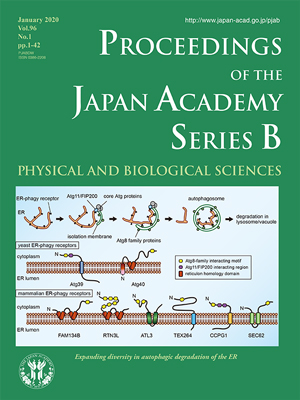About the Cover
Vol. 96 No. 1 (2020)
In autophagy, the double membrane vesicle autophagosome sequesters a wide range of cellular components and delivers them to lysosomes or vacuoles for degradation. Recent studies have established that certain molecules and structures in the cytoplasm (e.g., disease-related protein aggregates and defective mitochondria) are recognized by specific proteins called autophagy receptors and actively engulfed by autophagosomes. These selective types of autophagy have attracted researchers due to their direct linkage to human diseases. In these circumstances, in 2015, Nakatogawa and colleagues (see the review article pp. 1-9) discovered that the endoplasmic reticulum (ER) is also degraded by selective autophagy (ER-phagy) and identified two ER-phagy receptors, Atg39 and Atg40, in the budding yeast Saccharomyces cerevisiae. Since then, many researchers have entered the field of ER-phagy research, and in mammalian cells, six ER-phagy receptors have been identified to date. These ER-phagy receptors act to trigger the degradation of distinct ER subdomains in different physiological/pathological situations. ER-phagy has now become one of the hottest topics in autophagy, and future studies will further reveal the diversity of its mechanisms and biological significance.
Yoshinori Ohsumi
Member of the Japan Academy




